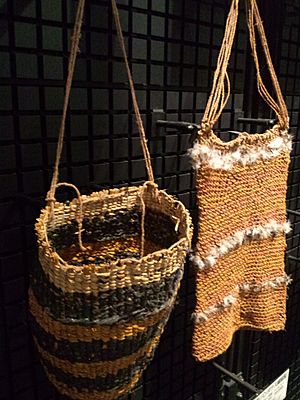Dillybag facts for kids

A dillybag is a special kind of bag made by Aboriginal Australians. It's usually woven from strong plant fibers. These bags were, and still are, mostly used by women to collect and carry food. You'll find them mostly in northern Australia.
Contents
What is a Dillybag?
The word dilly comes from the Jagera language, an Aboriginal language. In Jagera, the word dili means both the bag itself and the plants used to make it. Different Aboriginal groups might call these bags by other names. Some of these names include yakou, yibali, murkutu, or but but bags.
How Dillybags are Made
Dillybags are typically woven from tough vines or dried grasses. In places like Arnhem Land, Queensland, the Northern Territory, and northern Western Australia, people often use plants from the Pandanus family. These plants have long, strong leaves perfect for weaving.
Some dillybags are made to be worn like a small shoulder bag, with a cord around the neck. Most are oval-shaped and have a cord attached for easy carrying. Sometimes, the bags are lined with feathers or animal fur. This helps stop small pieces of food from falling out through the woven holes.
What are Dillybags Used For?
While women mainly use dillybags for gathering food, men sometimes use them too. For example, men might carry tools for hunting in them. Some dillybags are also used to hold important personal items or sacred objects.
Today, dillybags are not just practical tools. They are also created as beautiful works of art. People make them to show off their weaving skills and cultural heritage.
Dillybags Beyond Aboriginal Culture
The term "dillybag" has also been used by non-Aboriginal Australians. For instance, a small food bag carried by a swagman (a traveling worker) might be called a dillybag. Australians also use the term to describe similar bags for other everyday purposes.

